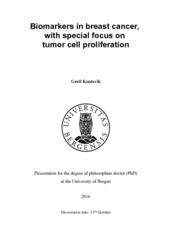| dc.description.abstract | Background: Breast cancer is a heterogeneous disease encompassing distinct subtypes that differ in incidence and prognosis. Better characterization of established biomarkers and exploration of novel biomarkers and possible treatment targets are important to improve prognostication and tailored therapy. A major challenge has been to predict which patients who are likely to suffer from recurrence and thus may benefit from adjuvant chemotherapy. Objective: This study aimed to compare three proliferation markers across distinct tissue categories, with association patterns and survival as end-points. Also, we aimed to explore the protein expression and potential prognostic impact of the novel proliferation-related biomarker QSOX1. Materials and methods: The thesis is based on three papers where a prospective, population-based series of breast cancer (n=534) was examined. In Paper I, the proliferation marker Ki67 was assessed by immunohistochemistry across matched samples of whole sections, WS (n=534), core needle biopsies, CNB (n=154) and tissue microarrays, TMA (n=459). In Paper II, mitotic count (mitoses per mm2) was assessed on H&E sections and PHH3 was examined by immunohistochemistry across matched samples (WS, CNB, TMA), and compared with the Ki67 values. In Paper III, QSOX1 expression was assessed by immunohistochemistry on TMA sections (n=458). Results: The proliferation markers (MC, Ki67, PHH3) showed significantly higher counts when assessed on WS as compared to CNB and TMA (Paper I-II). Tumor cell proliferation (MC, Ki67, PHH3) varied according to molecular subgroup with highest proliferation in the triple negative subgroup and lowest proliferation in the luminal category. In the luminal/HER2 negative subgroup, there were many discordant cases and only fair agreement when assessing luminal A and B on WS as compared to CNB and TMA (Paper I-II). Increased proliferation assessed by MC, Ki67 and PHH3 across all three sample categories showed significant associations with high histologic grade and hormone receptor negativity (Paper I-II). In univariate survival analysis, the prognostic impact of MC, Ki67 and PHH3 were mostly retained across specimen categories. In multivariate Cox analysis, adjusting for age, tumor size, histologic grade and nodal status, mitotic count and Ki67 maintained their independent associations with prognosis, whereas PHH3 did not (Paper II). High expression of QSOX1 was associated with high histologic grade, hormone receptor negativity, increased proliferation (MC, Ki67), and HER2 positivity (Paper III). High QSOX1 expression was more common among HER2+ and triple negative subgroups. In univariate survival analysis, cases with high QSOX1 expression (SI=9) showed a 10 year survival probability of 67% compared to 89% for carcinomas with low QSOX1 levels (SI=0-6). QSOX1 expression showed independent prognostic impact in multivariate Cox models adjusting for age, histologic grade, tumor size and nodal status. Conclusions: Assessment of proliferation markers on full sections, when available, should be regarded as current best practice (Paper I-II). For assessment on core needle biopsies, specimen specific thresholds should be considered. TMA is less suited for assessment of proliferation in studies with potential clinical impact (Paper I-II). Mitotic count might be used for sub-classification of the luminal group of breast cancers (Paper II). High QSOX1 expression in tumor cells is a marker of more aggressive breast cancer (Paper III). | en_US |
| dc.relation.haspart | Paper I: Knutsvik G, Stefansson IM, Aziz S, Arnes J, Eide J, Collett K, Akslen LA. Evaluation of Ki67 expression across distinct categories of breast cancer specimens: A population-based study of matched surgical specimens, core needle biopsies and tissue microarrays. PLoS One 2014; 9: e112121. The article is available at: <a href="http://hdl.handle.net/1956/9627" target="blank">http://hdl.handle.net/1956/9627</a> | en_US |
